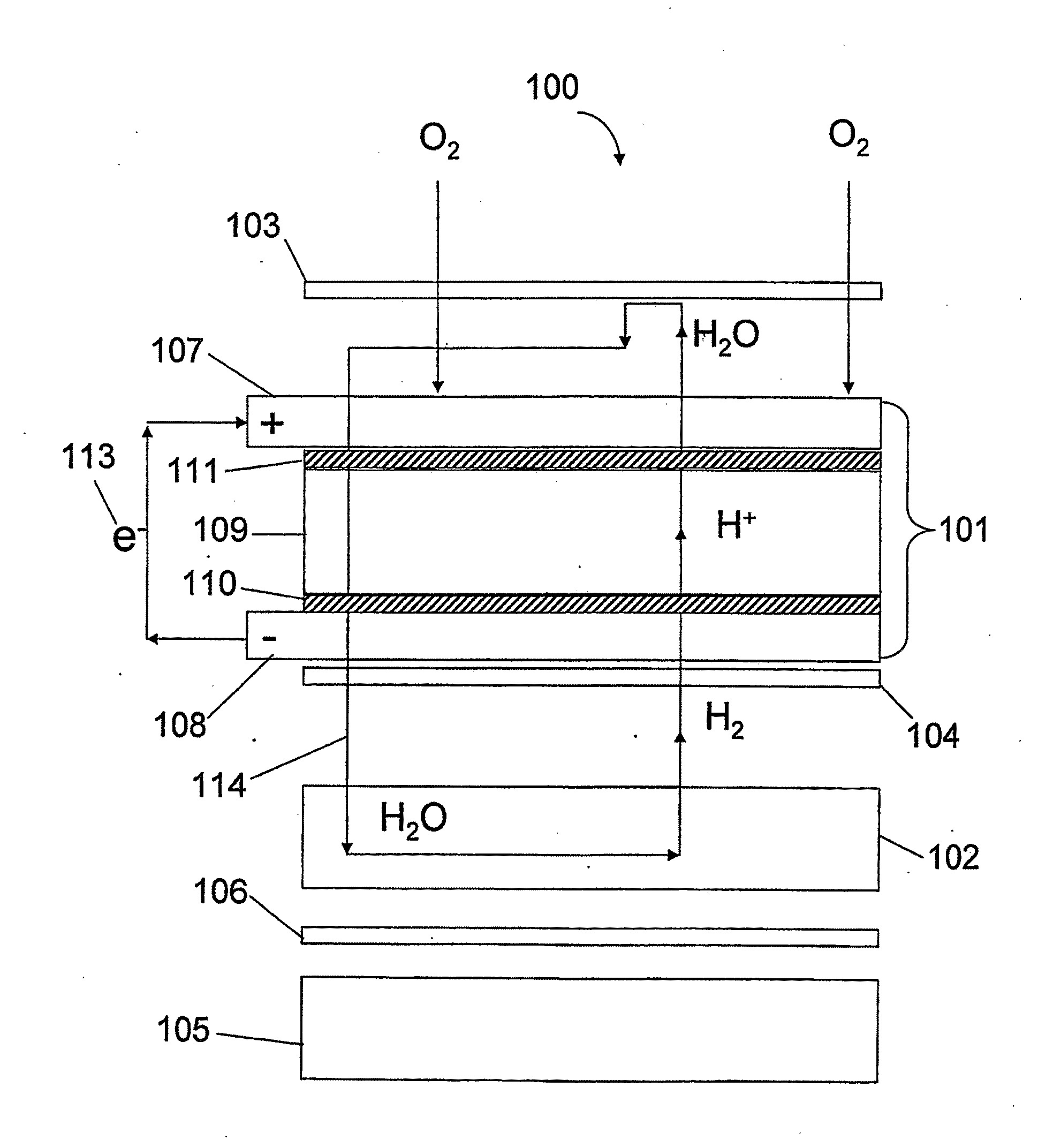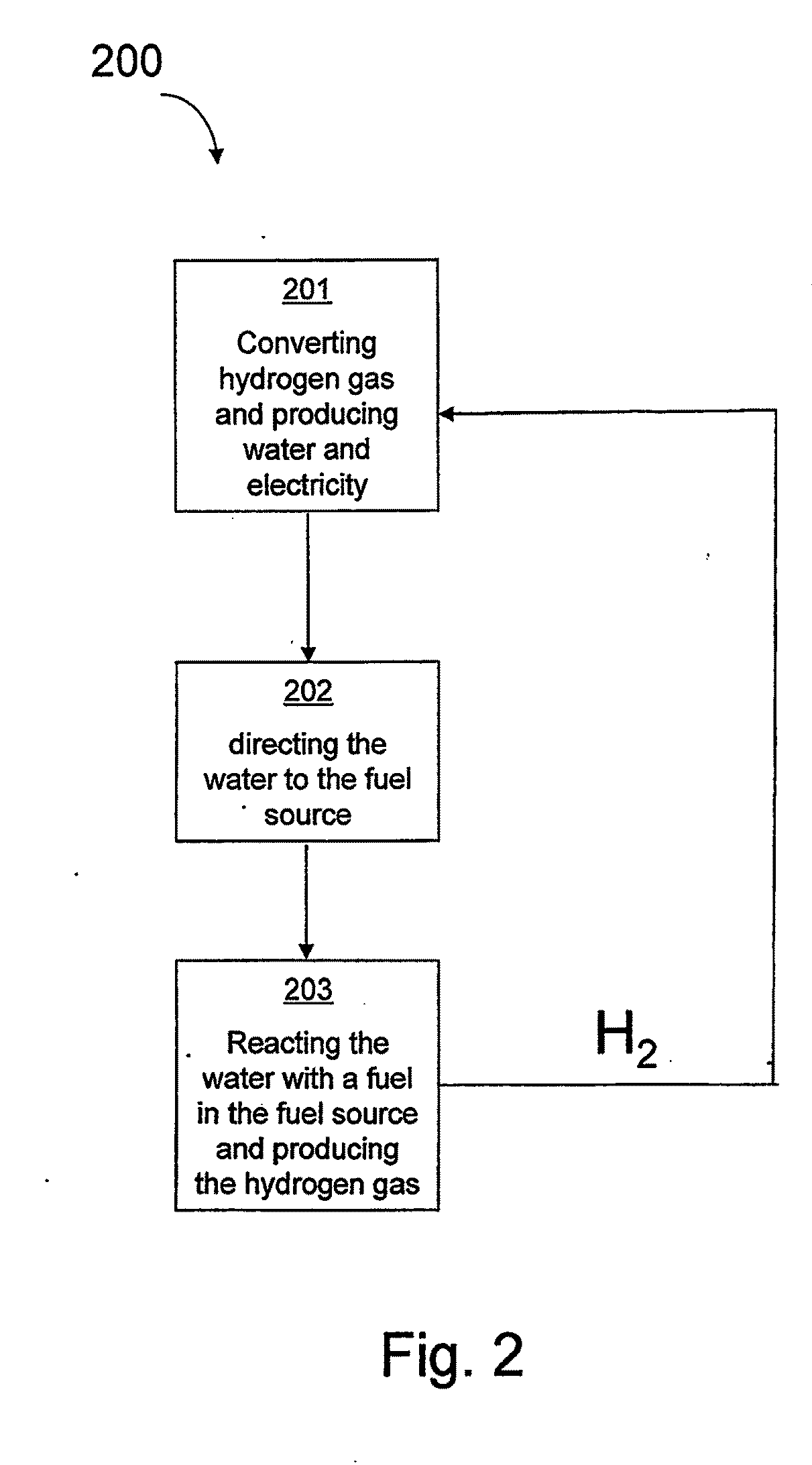Integrated Fuel and Fuel Cell Device
a fuel cell and fuel cell technology, applied in the field of integrated fuel and fuel cell devices, can solve the problems of limited energy density, limited ability of current chemical batteries to operate under continuous load, and limited service life of rechargeable batteries,
- Summary
- Abstract
- Description
- Claims
- Application Information
AI Technical Summary
Problems solved by technology
Method used
Image
Examples
example 1
[0118]An integrated fuel and fuel cell prototype device having a single fuel cell was constructed and tested. A fuel cell rated at 0.6V, obtained from Heliocentris Energie System GmbH (65×65×25 mm), was mounted on a housing made of machineable acrylic sheet. The dimensions of the integrated fuel and fuel cell prototype device were 65×65×85 mm. The fuel cell chamber was filled with 5 grams of NaBH4 powder and 0.01 g of a cobalt metal powder. Both materials were obtained from Alfa Chemical Corporation. The device included a 20 ml water reservoir separated from the solid fuel by an anionic membrane made by Sybron Chemicals. For this Example, the water reservoir was charged with 10 ml of water. An amount of at least about 500 μl water would be theoretically sufficient for initiating operation. The fuel cell open circuit potential was measured at 0.85 V. A small motorized fan was connected to the fuel cell. Under that load, the voltage was measured to be 0.6 V. In the first test of the d...
example 2
[0119]In example 2, a variation of the device described in Example 1 was made having a double membrane thickness, so that the water permeability varied from Example 1 and the water flux rate was reduced by 50% from that in Example 1. In this Example, the anion membrane material used in Example 1 was reinforced with a Nafion® membrane covering. The fuel cell open circuit potential was measured at 0.83 V. The motorized fan used in Example 1 was connected to the fuel cell, and under load the fuel cell voltage was measured at 0.6V. The fan was run continuously for 4 hours before being disconnected, and the integrated fuel and fuel cell device was shelved for 2 months. After the 2 month period, the fan was reconnected to the integrated fuel and fuel cell device, and run continuously for 25 hours before being disconnected.
example 3
[0120]In example 3, a device similar to that shown in FIG. 7 was made and tested. Four cells each rated at 0.6V, obtained from Heliocentris Energie System GmbH (65×65×25 mm), were mounted on a housing made of machinable acrylic sheet. The dimensions of the prototype device are 105×105×80 mm. A removable cartridge was made having a fuel chamber surrounding a cavity in the center of the cartridge. A fuel charge comprising 100 g of NaBH4 powder and 0.2 g of cobalt powder catalyst was placed in the periphery of the cartridge. A water reservoir having a capacity of about 30 ml was situated within the top of the housing, positioned above the fuel cartridge. The water reservoir was designed to have cylindrical hollow rods filled with Nafion tubing obtained from PermaPure LLC, joined to openings in the reservoir, and projecting into the cavity of the fuel cartridge. Water permeated into the fuel chamber from the 5 cylindrical hollow rods filled with Nafion tubes. The open circuit voltage of...
PUM
| Property | Measurement | Unit |
|---|---|---|
| voltage | aaaaa | aaaaa |
| voltage | aaaaa | aaaaa |
| open circuit voltage | aaaaa | aaaaa |
Abstract
Description
Claims
Application Information
 Login to View More
Login to View More - R&D
- Intellectual Property
- Life Sciences
- Materials
- Tech Scout
- Unparalleled Data Quality
- Higher Quality Content
- 60% Fewer Hallucinations
Browse by: Latest US Patents, China's latest patents, Technical Efficacy Thesaurus, Application Domain, Technology Topic, Popular Technical Reports.
© 2025 PatSnap. All rights reserved.Legal|Privacy policy|Modern Slavery Act Transparency Statement|Sitemap|About US| Contact US: help@patsnap.com



